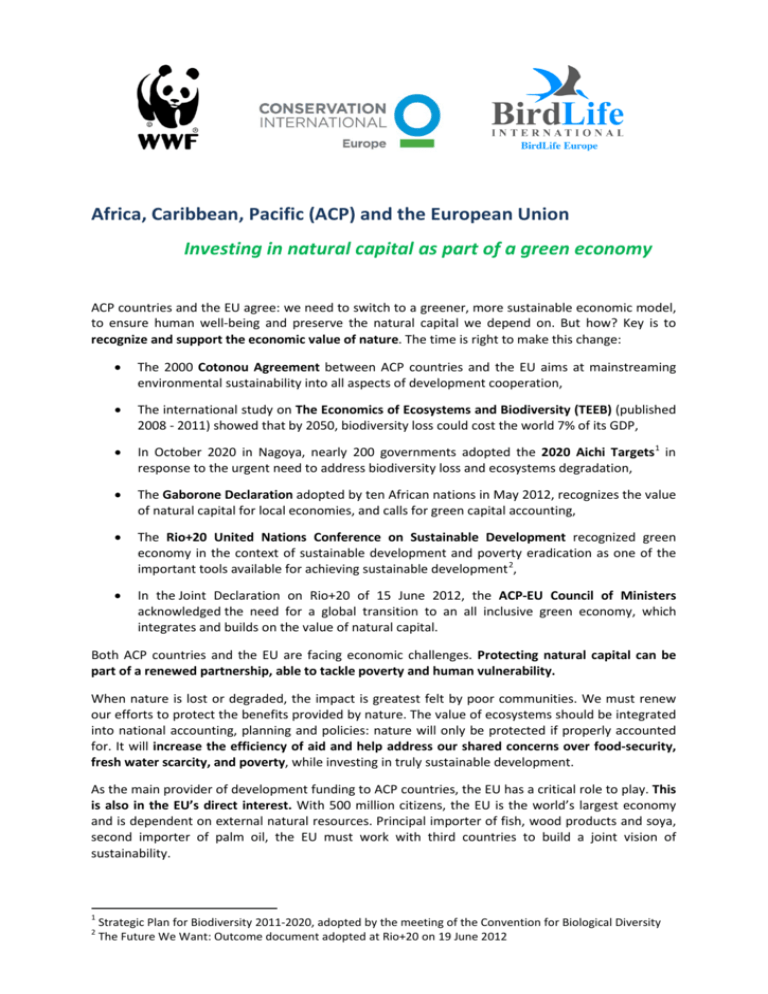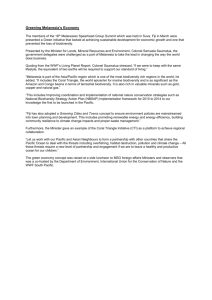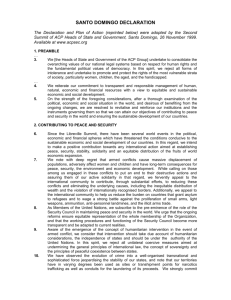(ACP) and the European Union Investing in natural capital as part of
advertisement

Africa, Caribbean, Pacific (ACP) and the European Union Investing in natural capital as part of a green economy ACP countries and the EU agree: we need to switch to a greener, more sustainable economic model, to ensure human well-being and preserve the natural capital we depend on. But how? Key is to recognize and support the economic value of nature. The time is right to make this change: • The 2000 Cotonou Agreement between ACP countries and the EU aims at mainstreaming environmental sustainability into all aspects of development cooperation, • The international study on The Economics of Ecosystems and Biodiversity (TEEB) (published 2008 - 2011) showed that by 2050, biodiversity loss could cost the world 7% of its GDP, • In October 2020 in Nagoya, nearly 200 governments adopted the 2020 Aichi Targets 1 in response to the urgent need to address biodiversity loss and ecosystems degradation, • The Gaborone Declaration adopted by ten African nations in May 2012, recognizes the value of natural capital for local economies, and calls for green capital accounting, • The Rio+20 United Nations Conference on Sustainable Development recognized green economy in the context of sustainable development and poverty eradication as one of the important tools available for achieving sustainable development 2, • In the Joint Declaration on Rio+20 of 15 June 2012, the ACP-EU Council of Ministers acknowledged the need for a global transition to an all inclusive green economy, which integrates and builds on the value of natural capital. Both ACP countries and the EU are facing economic challenges. Protecting natural capital can be part of a renewed partnership, able to tackle poverty and human vulnerability. When nature is lost or degraded, the impact is greatest felt by poor communities. We must renew our efforts to protect the benefits provided by nature. The value of ecosystems should be integrated into national accounting, planning and policies: nature will only be protected if properly accounted for. It will increase the efficiency of aid and help address our shared concerns over food-security, fresh water scarcity, and poverty, while investing in truly sustainable development. As the main provider of development funding to ACP countries, the EU has a critical role to play. This is also in the EU’s direct interest. With 500 million citizens, the EU is the world’s largest economy and is dependent on external natural resources. Principal importer of fish, wood products and soya, second importer of palm oil, the EU must work with third countries to build a joint vision of sustainability. 1 2 Strategic Plan for Biodiversity 2011-2020, adopted by the meeting of the Convention for Biological Diversity The Future We Want: Outcome document adopted at Rio+20 on 19 June 2012 The Caribbean The Caribbean region is known for its rich local cultures, beautiful landscapes and unique plants and animals; but the region is also facing serious environmental challenges. Tourism is threatened by pollution and the degradation of nature and scenic beauty. Climate change and hurricanes are a major threat, making it crucial to protect natural barriers like coral reefs and mangroves. The coral reefs of Tobago not only generate 100-130 million USD annually from tourism, but also provide shoreline protection services estimated to 18-33 million USD in potentially avoided damages 3. The importance of intact reefs in protecting shoreline will increase with rising sea level and increased storm intensity associated with warming seas. Throughout the region, many green initiatives are under way to tackle these challenges. The EU is well placed to support these efforts: the Caribbean has 16 ACP countries and several overseas territories or France, the UK and the Netherlands. EU funding can help to build green economies by developing renewable energy, reducing coastal pollution, supporting the protection and restoration of natural ecosystems, and implementing ecosystem-based adaptation to climate change. The Guiana shield The Guiana shield extends over 250 million hectares in the north-east of South-America, from Venezuela to the Brazilian state of Amapa. It is linked to the Caribbean - Guyana and Suriname are members of the Caribbean Community (CARICOM). The region is very rich culturally and is a treasure of the world’s biodiversity, with over 2200 vertebrate species and 1680 bird species. The Guiana shield has among the last remaining tropical forest wilderness areas on Earth4. These forests are crucial for the well-being of local communities, but also for the planet: they store 50 billion tons of carbon and 10-15% of all fresh water resources 5. These forests are under serious threat from logging and mining, both legal and illegal. Low Carbon, Sustainable and Green Development initiatives are under way, some of them supported by the EU and member states such as Norway, France and Germany. Such efforts are crucial for the stability of the global climate and deserve being increased further. By supporting regional cooperation and green initiatives in this part the world, the EU can support important benefits both for human well-being locally and for the stability of the global climate. EU investment in this part of the world makes sense: Guyana and Suriname are ACP countries, and French Guiana is a full part of the EU, meaning that the EU is directly involved in the heart of this important region, and has a special responsibility to take concerted action with its neighbours. 3 Coastal Capital - Economic Valuation of Coral Reefs in Tobago and St. Lucia, Burke et al. 2008 Brooks, T. M., Mittermeier, R. A. , da Fonseca, G. A. B., Gerlach, J., Hoffmann, M., Lamoreux, J. F., Mittermeier, C. G., Pilgrim, J. D. and Rodrigues, A. S. L. (2006) Global Biodiversity Conservation Priorities. Science 313 (5783) 5 Guiana Shield Facility 4 Africa Africa is home to some of the Earth’s most beautiful cultures and natural landscapes, and for the last 10 years the African continent has been showing signs of economic recovery, with average growth rates of at least 5%. However, many Africans remain affected by poverty, illiteracy, malnutrition and inadequate water supply and sanitation. A key challenge is that the pressure on Africa’s natural resources has increased massively in the last decades, due to population growth (from 220 million in 1950 to 1 billion in 2009) and to the growing global demand for natural resources, food and biofuels. The EU and African countries need to put natural capital at the heart of their dialogue on development and funding. The time is right: many African leaders fully understand the importance of natural capital to improve human well-being. This was exemplified in the Africa Consensus Statement to Rio+20 as well as the Gaborone Declaration. The Gaborone Declaration: 10 ACP nations commit to value natural capital In May 2012, the Government of Botswana hosted a “Summit for Sustainability in Africa” in partnership with Conservation International (CI). In the “Gaborone Declaration”, 10 African nations committed to put Nature at the heart of their development strategies. The text was also supported by leading development organizations and corporations such as the World Bank, the Gates Foundation, Rabobank, Unilever. All signatories committed to ensure that the contributions of natural capital to sustainable economic growth, social capital and human well-being are quantified and integrated into development and business practice. African nations are showing the way. For example Mozambique has developed a green economy roadmap in view of becoming an inclusive middle income country by 2030, based on protection, restoration and rational uses of natural capital and its ecosystem services to guarantee development that is sustainable, inclusive and efficient within the planetary limits. The Pacific Perhaps better than any other region, the Pacific demonstrates that people need nature to thrive. Many nations in the region owe their lives and livelihoods to the ocean’s natural resources. In others like Papua New Guinea, the majority of the population still lives in traditional societies and practice subsistence-based agriculture. In both cases, dependency on nature is very high. The region has 15 ACP countries and 4 EU Overseas Countries and Territories (OCTs). The EU’s Pacific strategy identifies “the sustainable management of natural resources” as one of the priorities in the dialogue with both ACP countries and OCTs in the region. In fact, environment should be the central focus of EU support to the region. Protecting tropical forests and coral reefs in the Pacific is of global significance in terms of both biodiversity and climate change, and is absolutely critical to maintain the way of life of Pacific islanders. EU and ACP countries - ways forward The Millennium Development Goals (MDGs) adopted by the United Nations in 2000 have galvanized efforts to meet the needs of the world’s poorest nations. The EU is a major contributor to these efforts. However, three years ahead of the 2015 target, many of the MDGs remain off track. One way of increasing progress is to invest in natural capital. We recommend the following: 1. An EU wide strategy on the integration of environment in EU development cooperation Such a strategy was requested by the EU Council in its conclusions of June 2009. It is time for the European Commission to prepare it with recipient countries, member states, the European Parliament and civil society organisations both from the South and the North. The strategy should support the mainstreaming of natural capital into informed economic decision-making. 2. Policy Coherence for Development As required by the Lisbon Treaty, the EU needs to analyse and tackle the impact of all EU policies (agriculture, fisheries, biofuels, trade...) on developing countries. Both the EU and recipient countries need to recognize the importance of conserving biodiversity and ecosystem services as a basis for ensuring food security and truly sustainable development. 3. Transparency and adequate assessments Both the EU and ACP governments must support a culture of openness and transparency on development policies and the attention to environment, by publishing relevant information, encouraging participation, and having adequate monitoring and evaluation tools. Strategic Environmental Assessments (SEA) and Environmental Impact Assessments (EIA) should be used on a systematic basis across all aid and development programmes. 4. Attention to natural capital in the whole “programming dialogue” Natural capital should have a prominent place in the “programming dialogue” between the recipient countries and the European Commission. Civil society should be consulted and national institutions responsible for ecosystems should be fully involved. National spatial planning and sustainable development planning should be supported. 5. Specific sources of funding for ecosystems The EU and ACP countries must ensure that sustainable, beyond project, sources of funding are available for biodiversity such as trust funds, payments for ecosystem services as well as small grant facilities that can be accessed by Civil Society Organisations. November 2012 Contacts: Jean-Philippe Palasi, Director for EU Policy, Conservation International - Europe jp.palasi@conservation.org, +322 537 62 68 Bruna Campos, EU Financial Perspectives Policy Officer, BirdLife Europe & CI-Europe bruna.campos@birdlife.org, +322 238 50 92 Pictures: CI/Janny “Heintje” Rotinsulu, Jeff Yonover, Cristina Mittermeier/iLCP, CI/Kim McCabe






